Bucket Cruising
- or -
How I Avoid Embarrassment
at the Launch Ramp
As of this writing it is mid-April here in the heartland of
America, and we can pretty-much be assured of no more hard-freezes.
So last weekend I took advantage of a sunny day to do a little
"bucket cruising" as I call it; namely, test-running
the outboards in an old 55-gallon plastic drum that I keep around
for such uses.
Also, last Saturday was my first day on the water this year;
two hours spent paddling the "Lars-breve" around a
small local river. While returning to the launch ramp, I noticed
a run-of-the-mill fiberglass runabout on a trailer backed down
to the waters edge. But rather than launching, the boat shortly
took a trip back up the ramp to the parking area, where the
owners removed the cowl and proceeded to "shake-wires"
and such.
Obviously, someone's day on the water had ended prior to it's
beginning.
I try to minimize my chances of such a calamity be-falling my
"first cruise" of the season by always test-running
my outboards in the plastic drum. Although mostly there have
been no problems, the test run does occasionally catch a problem
that has cropped-up during winter storage.
Which brings me to "winterization" procedures. Most
everyone has heard/read the recommendations concerning the use
of engine "fogging" oil, and of "running the
gas out of the carb," and such. All this advice is well
and good, and I certainly recommend that you follow it.
I don't.
I suppose I am just lazy, but I never use fogging oil, and I
never "run the gas out" of my outboards. So far, the
5- or 6 month downtime over the winters in this part of the
continent have not caused me any trouble as far as gasoline
congealing in the carbs. I might add that "running the
gas out of a carb" usually does not. Get all the gas out,
I mean. In order to really get all the gasoline out of the carb,
you need to run it until the engine stops, and then drain the
carb. bowl, either through a drain plug (which some carbs have)
or by removing and dumping the bowl (for those carbs lacking
the drain plug.)
If I happen to think about it, I do use some gasoline "stabilizer"
in the fuel tanks, which would help the carbs survive the winter
un-gummed, but I don't remember remembering to add it last year,
so two of my three outboard fuel tanks also sat all winter with
un-stabilized gasoline in them.
This is the gasoline I used to test-run the engines. Both engines
ran well in the bucket, and I experienced no problems. So I
intend to use this gasoline this year, maybe adding a bit of
new gas to "freshen it up." Considering the current
price of new gasoline, and the costs involved in properly disposing
of old gasoline, It makes sense to use it if I can.
All this should not be taken to be a recommendation for slovenly
outboard motor maintenance, but rather a treatise that sometimes
compensating factors might exist.
I see no need for fogging oil, for example, because I run my
outboards on very "rich" oil mixtures. Modern outboards,
running on 50-to-1 ratios (or even less, in the case of oil-injected
versions) need to have the fogging oil so as to prevent internal
corrosion during long periods of storage in damp areas.
My old OMC's, however, carry recommendations of 24-to1 oil mixture
ratios, or twice as much oil per gallon of gasoline as the 50-to-1
engines get. And since I generally consider my engines to be
in "severe service" (running relatively small engines
on relatively big boats) I usually run my engines at a richer
mixture than the recommendation; with the '50s OMC's, that usually
means 16-to-1. Back in the old days, before TCW-III oils came
along, running 2-cycle outboards on this rich of an oil mixture
could lead to spark plug fouling (no big deal) or carbon-clogged
piston ring grooves (big deal), but I have not experienced a
fouled spark plug since 1994, which is a tribute to the modern
2-cycle engine oils. And a dab or two of carbon remover, mixed
into the gasoline at a ratio leaner than that recommended for
modern engines, keeps the rings free and seating.
All this extra oil thoroughly coats the engine's innards and
does the same job as the fogging oil; preventing corrosion during
storage. During the mid '80s, OMC recommended running some of
their then-new outboards at 100-to-1 oil ratios, but later changed
that to 50-to-1; not because the leaner ratio had any lubrication
issues, but rather because there was too little residual oil
left within the engine at the 100-to-1 ratio to protect the
engine from corrosion during storage.
So that is the "compensating" factor not using fogging
oil; the compensating factor for not draining carbs is simply
luck, and the fact that I can clean an old OMC carb almost as
fast as I can drain it, so it is no big deal if it does plug-up.
One caveat that might cost you some caviar: if your outboard
has two or more carbs, you want to take good care of them. If
an outboard with a single carb experiences a plugged carb, the
engine stops. On outboards, multiple carbs feed individual cylinders;
i.e. if the carb feeding one cylinder plugs up, that cylinder
receives no fuel mixture, hence no lube oil, while the other
carb / cylinder combo(s) continue to keep the engine running.
The result of this situation is a "blown" engine.
One plugged carb on an outboard with multiple carbs can cost
you big-time.
There is, however, one area of "winterization" that
I never skimp on; I ALWAYS drain and refill the lower units
of my outboards. Most of these leak water into the lower units
to some degree, and to allow the motor to sit through freezing
weather with water in the lower unit is to virtually guarantee
having a cracked lower unit in the spring. Why not just re-seal
the lower unit, you ask? Because getting one of the old two-piece
lower units sealed-up tight is a real chore. You can replace
the prop shaft seal, for example, but if the shaft is scored
from having fishing line wrapped around it several times in
the decades since the motor was new, the new seal isn't going
to seal very well. Same situation if the bearing that supports
the vertical driveshaft in the lower unit (a cast-in-place,
non-replaceable bushing on many old OMC's) is a bit worn and
the shaft wobbles a bit; the seal under the waterpump isn't
going to last long either.
So I make it a point to buy the cheapest lower unit oil I can
find, and to change it several times during the boating season,
and to ALWAYS change it before freezing weather arrives. And
if I go boating during freezing weather, I always change the
oil after each use.
Or you could buy a new prop shaft (assuming one is available)
or have the old one "built-up" with weld and then
"turned-down" to size on a lathe. Your choice.
For those that don't want to keep a grungy oil drum around the
house for outboard testing,, there are flush attachments available
for newer engines, and one occasionally sees them for old engines,
but remember that water pressure from a garden hose might mask
a waterpump problem.
Of course, there are many people out there who will not agree
with some/all of the above.
This is just my opinion.
And I always have one.
Max
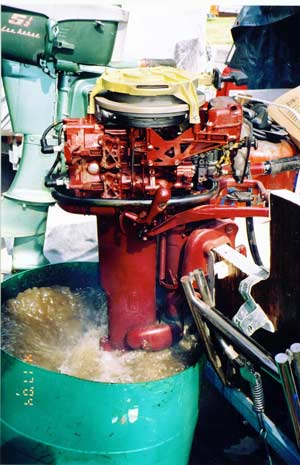
The '57 Johnson 18 hp churns the wild waters of the test bucket
during it's first run of the year.
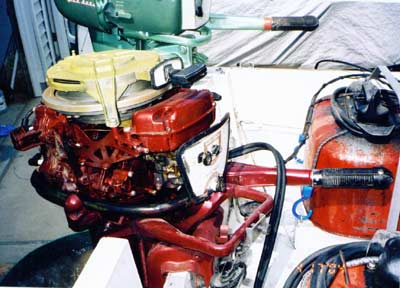
The only "repairs" that the 18 required was to have
it's packing nuts tightened. What are "packing nuts,"
you ask? Obviously you need to review the column on carburetors.
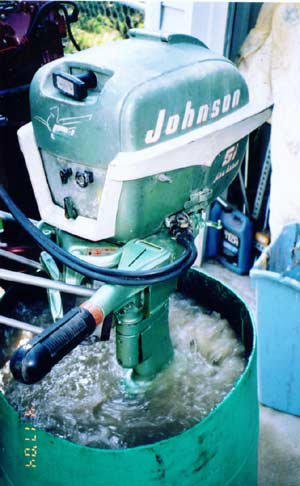
Now the '55 Johnson 5 1/2 hp, subject of the "Start
to Finish" series, gets it's chance to blow a little
smoke.
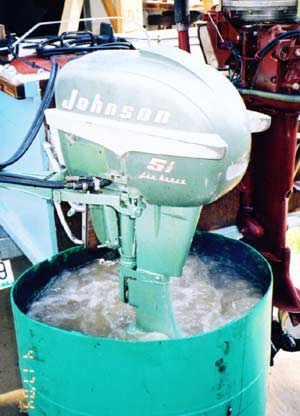
Keep in mind that an outboard run in a bucket for too long can
overheat. Keep an eye on it.
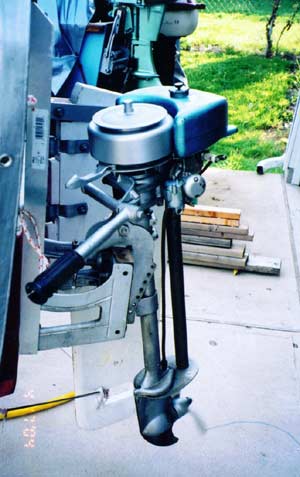
Here is what you should not do; run a water-cooled outboard
with no cooling water. How come I can get away with it? Because
this old 1945 Neptune (Muncie Gear Works) 2 hp has a metal impeller
in it's pump. Anyhow, it is a bad idea to leave the prop on
while running an outboard like this; highly dangerous. The Neptune,
auxiliary engine on my AF3 sailboat, needed only a new rubber
fuel line and plastic fuel filter to be in running condition,
after sitting out all winter covered by a plastic grocery bag.
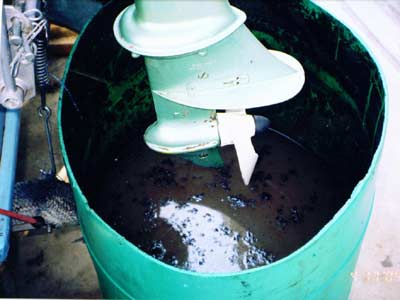
Here's what you are left with after test-running old 2-cycle
outboards in a bucket; polluted water. When you are boating,
this residue gets left in the lake/ river/ ocean etc. I make
no claims as to the environmental-friendlyness of old outboards.
Just as those who drive mammoth gas-guzzling SUV's, and who
live in houses much bigger than they need, and who continually
dump assorted chemical weed killers and fertilizers on their
lawns, and who run their air conditioners unceasingly during
hot weather should not make claims as to their own "environmental
friendliness." By the way, the crud shown here took about
a year or so to accumulate; I leave the bucket full, even over
the winter, so as to avoid dealing with disposing of the crud.
Max

|

